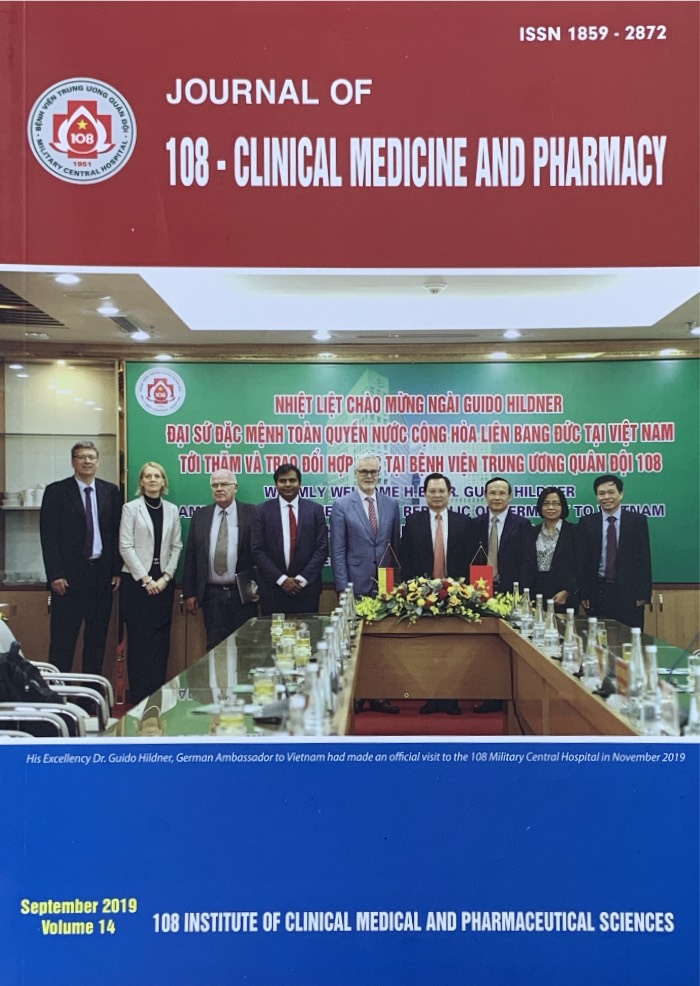Results of combination of percutaneous nephrolithotomy and extracoporeal shock wave lithotripsy in treatment of staghorn calculi
Main Article Content
Keywords
Tóm tắt
Objective: To evaluate the outcomes of treatment of staghorn calculi by combination therapeutic approach of percutaneous nephrolithotomy (PCNL) and extracorporeal shock wave lithotripsy (ESWL). Subject and method: A prospective study carried out from September 2014 to September 2017, 80 patients with staghorn calculus underwent combination therapeutic approach of PCNL and ESWL. Result: Mean age was 54 ± 11 years (27 - 78), size of stone was 46 ± 13mm, average operation time for PCNL was 129 ± 27 minutes, the mean of the number of shock wave in the first time was 2410 ± 797 and the second time was 2614 ± 561. Postoperative length of stay was 7.3 ± 2.2 days. The number of tracts required per patient was 1 tract in 92.5% (74/80) and 2 tracts in 17.5% (6/80). The stone free rate after 3 months was 55.2%. Common complication rate was 27.5% (22/80), bleeding required transfusion was 6.2% (5/80), fever was 22.5% (18/80) and there were 1 case had ureter stone after removing double J stent (1.3%) that was required ureterorenoscopy. Conclusion: Combination therapeutic approach of percutaneous nephrolithotomy and extracorporeal shock wave lithotripsy is a good option, safety and effectiveness for treatment of staghorn calculi.
Article Details
Các tài liệu tham khảo
2. Singh R, Kankalia S, Sabale V et al (2015) Comparative evaluation of upper versus lower calyceal approach in percutaneous nephrolithotomy for managing complex renal calculi. Urology annals 7(1): 31.
3. Sampaio B, Zanier C, Aragão M et al (1992) Intrarenal access: 3-dimensional anatomical study. J Urol 148: 1769-1773.
4. Lê Sỹ Trung, Barbe Y P, Bire J et al (2012) Nội soi thận qua da điều trị sỏi san hô: 10 năm kinh nghiệm của Bệnh viện Việt Pháp Hà Nội. Y Học TP. Hồ Chí Minh 16(3): 249-254.
5. Chen J, Zhou X, Chen Z et al (2014) Multiple tracts percutaneous nephrolithotomy assisted by lithoclast master in one session for staghorn calculi: Report of 117 cases. Urolithiasis 42(2): 164-169.
6. Liang T, Zhao C and Wu G (2017) Multi-tract percutaneous nephrolithotomy combined with EMS lithotripsy for bilateral complex renal stones: our experience. BMC Urology 17(15): 205-207.
7. Jackma VS, Hedican PS, Peters AC et al (1998) Percutaneous neuphrolithotomy in infants and preschool agr children: Experience with a new technique. Pediatric Urology 52(4): 697-701.
8. Liu C, Zhang X, Liu Y et al (2013) Prevention and treatment of septic shock following mini percutaneous nephrolithotomy: A single-center retrospective study of 834 cases. World J Urol 31(6): 1593-1607.
 ISSN: 1859 - 2872
ISSN: 1859 - 2872
